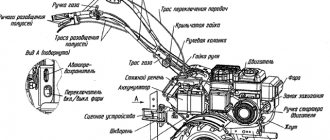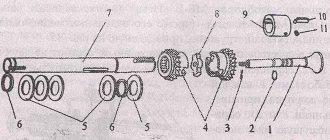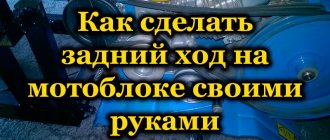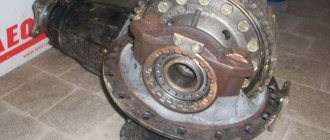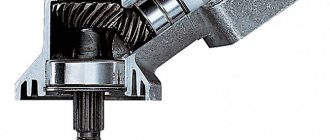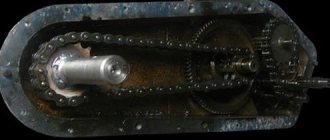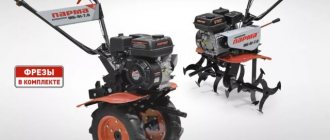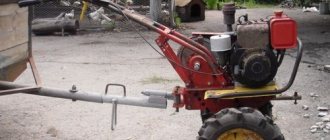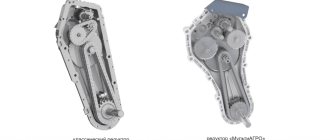For modern gardeners, cultivating a plot of land is no longer as big a problem as it was in the recent past. Such universal equipment as walk-behind tractors has appeared on sale, which make life much easier for agronomists and gardeners.
Neva walk-behind tractors are one of the best units in their line. They are reliable, durable and multifunctional. You will be able to cultivate the land, care for plants, and collect and transport crops and garbage.
Here we will tell you about the gearbox for the Neva walk-behind tractor, its design and repair. This is one of the most significant elements in any car, so if you want it to last a long time and without breakdowns, you must know all the intricacies of its design, as well as the causes of malfunctions and methods for eliminating them.
Repair and maintenance of walk-behind tractors Neva MB-2
The Neva MB-2 walk-behind tractor is an agricultural unit designed to work on a wide variety of soil types, including previously uncultivated soil.
Available in various modifications with different types of engines:
The main work that can be performed on the Neva MB-2 walk-behind tractor is:
- plowing the soil;
- cultivation, milling;
- watering (pumping station);
- hilling;
- cleaning areas from grass, snow, etc.;
- harvesting potatoes, onions, etc.
How is it arranged?
Despite the fact that St. Petersburg produces a wide range of Neva walk-behind tractors, differing in power and configuration, the gearbox in all these devices is designed according to a single general design. According to the principle of operation, the gearbox used is of the gear-chain type, where the change in rotation speed is carried out due to the interaction of a system of gears of different diameters and with a different number of teeth, which are either in direct contact with each other or are connected by a chain transmission.
Operation and maintenance of Neva MB-2
Changing the engine oil
The manufacturer recommends using such well-known brands of motor oil for the walk-behind tractor as LUKOIL - standard SAE 10W30 API SF/CC, as well as RAVENOL SAE 30 API CD/SF.
At temperatures above 4 degrees Celsius, using thickened types of oils (for example, 10W30 brand) will lead to increased consumption of this type of fuel, so in the cold season it is recommended to check the engine oil level more often, preventing its level from dropping below normal.
The oil change is carried out after the walk-behind tractor has recently been in operation, while the engine has not yet completely cooled down. It should be warm, but not hot. The remaining oil is completely drained from the tank, after which new oil is added until the oil level reaches a special mark. The drain plug is then tightened tightly and wiped dry.
First launch and testing of the Neva MB-2 walk-behind tractor
The first start must be carried out according to the following scheme:
- make sure that the walk-behind tractor is in complete condition (the height of the steering bar and handles must correspond to the user’s height);
- You can start the engine only if the walk-behind tractor is located on a flat surface;
- check the oil and fuel levels in the tank;
- also check the places of threaded connections;
- then you can start the engine by smoothly turning the ignition knob;
- The idle time (without load and movement) should be about 10 minutes, then you can move and operate the walk-behind tractor.
The break-in period is considered to be the first 20 hours of operation of the walk-behind tractor, after which the oil must be changed. During this period it is most important:
- do not operate at full throttle;
- work only on pre-prepared soils (not virgin soil);
- for cultivation, use only the number of cutters that are included in the kit;
- The Neva MB-2 walk-behind tractor can only be loaded at ¾ power during the run-in period;
- gear shifting in the gearbox can only be done when the rotation of the drive pulley has completely stopped;
After the first 20 hours of operation after the first start, the engine oil should be changed.
Step-by-step instruction
Kinematic diagram of a mini tractor.
First of all, a kinematic diagram of the future mini tractor should be developed. If you have some experience, you can make such a scheme yourself or find ready-made options on the Internet. It is quite possible that you will be lucky enough to find drawings for converting a mini tractor from a walk-behind tractor for a specific model. This will greatly facilitate further work. In addition, you can find a lot of video material on the Internet showing the assembly and modernization of such units.
Frame and body
The material for making the frame can be metal corners and pipes. To fasten various elements, it is better to use a bolted connection, which means you will need a drill, as well as a welding machine, since welding is indispensable. It is advisable to achieve an optimal ratio of frame weight and strength.
Whether to make a body or not is a matter of taste. However, with a body, a minitractor assembled with your own hands, for example, on the Neva base, looks more presentable, and besides, it creates additional protection from dirt for the driver and various components. For the body it is best to use stainless steel.
Seat and steering
After the body is made and hung, the driver's seat needs to be installed. At car dismantling sites you can find a front seat from an old passenger car. The main thing is that the chair is comfortable.
DIY steering wheel installation should be done after the seat is attached to adjust the angle and height. You can choose the principle of the steering system used on go-karts. Of course, you will have to make the rods stronger and shorter, since in this case the forces will be much higher. Just like the seat, the steering wheel can be found at auto wrecking yards.
Choice of wheels and tires
If you want to save money, you can take wheels from an old passenger car, but this will create certain difficulties when operating a ready-made mini tractor. For such a unit, the front wheels should ideally have a diameter of 12-14″. With a smaller diameter, the minitractor will bury its “nose” in the ground, and with a larger diameter, control will be difficult. Tires, accordingly, are selected to match the size of the wheels installed on the mini tractor.
Installation of levers
To make control more convenient, it is necessary to provide for the installation of levers that will be responsible for the brake and clutch. The simplest method, which is preferred by many craftsmen, is to install a cable drive connected to the motor block.
Basic faults
Belt adjustment and dimensions
For the Neva MB-2 walk-behind tractor, the A-1180 drive belt is used. This model uses one belt that provides forward movement.
In other modifications of the Neva MB-2 model, two drive belts are used. Reverse gearing occurs in the gearbox itself.
Replacing the belt for MB-2 walk-behind tractors is carried out in the following sequence:
- The shield is removed, and then the pulley protective cover.
- The spring from the walk-behind tractor rod is removed to loosen the belt.
- The screws securing the bracket are turned.
- The bracket rotates to a position in which the limiting pins do not prevent the part from being removed from the pulley.
- The pulleys are adjusted, and then a new belt is installed.
- Pull the belt onto the gear shaft pulley, and then onto the motor pulley.
- In reverse order, place the remaining parts in their places.
Replacement of gearbox seals
The oil seals in the Neva MB-2 walk-behind tractor are replaced if an oil leak is detected. This condition is dangerous because the walk-behind tractor gearbox may be left without oil, and this will lead to rapid wear of the unit.
The sequence for replacing oil seals is as follows:
- Remove the cutters from the shaft, cleaning the shaft and covers from dirt and oil residues.
- Unscrew the cover bolts, tap off the oil and debris, and remove the cover from the gearbox.
- The old oil seal is replaced with a new one and wiped dry.
- The cover is returned to its place (if necessary, it is placed on sealant) and fixed with bolts.
Adjusting and tuning the Neva MB-2 carburetor
The functionality and durability of the walk-behind tractor engine depends on the stable operation of the carburetor. This is why its adjustment and tuning are so important. In addition, if the carburetor is incorrectly configured, a gasoline walk-behind tractor may experience increased fuel consumption
The carburetor of the Neva MB-2 walk-behind tractor is adjusted as follows:
- The full throttle and idle screw are turned to the limit.
- Both screws are unscrewed 1-1.5 turns.
- Next comes starting and warming up the engine.
- The throttle control lever is placed in a position in which the engine will operate at minimum speed.
- Set the minimum idle speed until the unit operates stable.
- The idle speed is set to maximum.
- The minimum idle speed is adjusted.
- Steps 6 and 7 are performed until the engine runs smoothly (more smoothly by ear) at idle speed.
For long-term and uninterrupted operation of the walk-behind tractor, it is necessary to regularly perform engine diagnostics, monitor the frequency of oil changes, and also comply with operating conditions and time intervals for scheduled maintenance.
Adjustment of valves
Adjusting the valves is a fairly simple procedure that requires wrenches, screwdrivers and a feeler gauge. The valve adjustment process is needed to establish optimal and technically correct clearances between the valves of a walk-behind tractor engine. Adjusting valves using the example of the Neva MB-23 walk-behind tractor (the principle is the same for everyone)
The adjustment sequence is as follows:
- remove the casing that covers the engine;
- remove the valve box cover;
- make adjustments (see below);
- Reinstall the valve box cover;
- Replace the casing.
The valves are located under the valve cover. The gap size can be checked with a feeler gauge. The intake valve clearance is 0.15 mm, and the exhaust valve clearance is 0.2 mm. The dipstick should fit under the valve with the correct gap size.
To adjust, the valve nuts are loosened, then a feeler gauge is inserted, after which the adjustment itself is made, and the valve nut is tightened.
The manufacturer emphasizes that in Neva MB-2 walk-behind tractors, the gaps between the ends of the valves and the ends of the pushers (0.1÷0.2 mm) are ensured by grinding the ends during the initial assembly of the engine and are not adjusted during operation!
Checking and adjusting the clutch of the Neva MB-2 walk-behind tractor
The main function of the clutch is to connect the gearbox to the engine, disengage it, and also connect other operating devices to the engine. If an overload occurs during operation, the clutch begins to slip - this is how other parts of the walk-behind tractor are protected from damage.
Checking the clutch operation can be done according to the diagram below.
If the clutch lever is in the disengaged position, the clutch cable is loose. Consequently, the tension roller lowers and comes into contact with the drive belt. After which the drive belt and small roller move to the lowered position - this stops the supply of power from the engine to the transmission.
Theoretical foundations of heat engineering - solid fuel combustion
There are quite a lot of energy sources in the modern world:
- Natural gas is available over large areas. It is enough to open the burner and light it, and a bluish light appears, which releases a significant heat flux.
- The liquid fuel supplied through the injectors burns with a bright red or yellowish flame. Even heat engines use different types of liquid energy carriers.
- Coal and its processed products have a long combustion cycle. The reddish flame gives off heat for a long time not only by convection; a powerful flow of thermal radiation reaches all surrounding objects.
- Firewood was the first available source of heat. They remain relevant today.
Many homes use stove heating. Baths and saunas, when advertising their services, indicate that they use wood of certain tree species as a heat source. Outdoor cooking traditionally involves the use of wood in the technology of cooking food.
Attention! Firewood chopped into logs is placed in woodpiles. They dry out
The moisture inside the wood evaporates rapidly. The apparent heat of combustion increases, since there is no need to waste energy on evaporating the liquid located in the intercellular space.
In thermal engineering, the following concepts have been introduced to characterize fuel:
- The highest calorific value, implying the total heat released during the combustion of a specific type of combustible substance.
- The lower calorific value is the actual amount of heat, which takes into account the energy costs for heating the fuel and the removal of ingredients from it during the combustion process that are not involved in the process itself.
Therefore, drying firewood is a technique that improves the performance of a fuel cell. Pre-grinding increases the efficiency of drying firewood, and subsequently burning it in a stove or other device for burning solid fuel.
A number of metalworking enterprises produce wood splitters. Based on their operating principle, they are divided into several types:
- Cleavers are installations for chopping action. The logs are placed on special supports, and then blows are applied with a weighted chisel.
- The chopping wedge is placed motionless, and the objects to be split are supported on them. The blows are applied with heavy sledgehammers, the splitting is carried out when passing through a passive working element.
- Pressers are installations with a mechanical pusher drive. The log is laid on a bed, and then it is pushed through a flat or cross-shaped knife.
- Screw destroyers are embedded inside the layered material. Penetrating deeper, they split even strong and twisted wood.
We invite you to familiarize yourself with Roses, angel wings from seeds. A spring-loaded wood splitter is the simplest device for splitting firewood.
The main element of the device is a spring. It is attached to the frame. The upper part of the spring rests against a fixed crossbar on which the cutting cleaver is installed.
In this case, the spring takes on the entire load; its responsibility is to hold the cleaver. Our task is to select a spring and a splitting cleaver so that minimal effort is applied to the work, but sufficient to split hard wood. The spring stop can be made mobile. Such a wood splitter must have a minimum height of 800 millimeters.
Experience of owners of operating the Neva MB-2 walk-behind tractor - reviews from forums
Each farmer's experience is unique. The advice of those who use the same walk-behind tractor as you do on their plot of land is especially valuable. Next - some advice from owners of the Neva MB-2 walk-behind tractor regarding maintenance and troubleshooting.
Vitaly, Penza, Russia:
“I bought a Neva mb2 walk-behind tractor and was very pleased. The unit worked normally at first, but a week after the start of operation, white smoke began to emerge from the exhaust pipe. I tried to slow down the engine speed, but it didn't help. It turned out there was water in the float chamber. I drained the gasoline, let it settle, and drained the chamber. After that the walk-behind tractor worked perfectly. If anyone has had a similar problem, I advise you to use my experience!”
Alexey, Rostov-on-Don, Russia:
“I encountered the following problem: in first gear my walk-behind tractor cultivated normally, but when I switched to second gear and worked with the soil, the engine speed did not drop. When I went deeper into the ground, the cutters stopped. Knowledgeable people suggested that the problem might be in towing the belt. I adjusted the tensioner and shortened the chain on the clutch handle and the problem was solved! Now I work with pleasure, I’ve been using my Neva MB2 for two years now.”
Konstantin, Rivne, Ukraine:
“I’m not new to working with a walk-behind tractor; I’ve been using it for 4 years. Recently, if you put a load on it, the engine began to stall, as if it couldn’t pull... I barely drove it into the garage, and there was no popping noise, no smoke. The cause of the malfunction was simple: the air filter was clogged. I had to replace it and now the car runs like a beast.”
You can also help other readers of our site with your reviews on this walk-behind tractor model and its maintenance and main faults.
If you are the owner of this walk-behind tractor model, you can leave a review about its maintenance and operation, or ask any question you are interested in regarding the breakdown or maintenance of this model below in the comments.
Engine DM-1-01 and its modifications
The Neva walk-behind tractor is equipped with an economical 6 hp engine. With. Working fuel is used: gasoline grades AI-80, AI-92 in accordance with TU-38.001165-2003. The carburetor is equipped with an air filter, allowing easier starting at low temperatures. Automatic decompressor reduces starting force. Stable operation is ensured by contactless electronic ignition.
The engine consists of parts:
- crank mechanism;
- gas distribution systems;
- fuel mechanism;
- air supply and removal of processed gases.
Ignition of the walk-behind tractor is necessary to ensure uninterrupted sparking in the spark plug.
Before starting work, the engine is depreserved. The fuel tank is filled with gasoline in the amount of 2 liters, and the cold (unheated) engine is started.
Some users do not know how to increase the crankshaft speed. Excessive load without warming up the engine leads to rapid wear of the piston pairs and, as a result, causes them to jam.
Gearbox design on the Neva walk-behind tractor
The gearbox of the Neva walk-behind tractor is responsible for transmitting the rotation coming from the motor to the wheels and attachments. It controls the rotation number, speed, and direction - forward or backward. In principle, the gearbox for models MB 2 and MB 1 is not much different, so here we will consider the second option. The gearbox is designed in such a way that the components necessary for changing gears are located on its outer part of the housing.
The gearshift lever has 5 positions. When you push it, the fork disengages the clutch. When you drop the lever, the fork resumes its original position. The walk-behind tractor will pause when the drive is connected to the right axle shaft. Torque comes from the sprocket. When the handle is recessed, engaging the left sprocket, the gear is reduced. If you need top gear, the handle needs to be pulled out all the way.
Peculiarities
The design of the walk-behind tractor is equipped with a gear-chain unit, the main task of which is to transmit rotational motion, and therefore to change the rotation speed of the cutters. It is thanks to the gearbox that the driven pulley transmits the mechanical action to the wheels of the equipment, thereby changing the speed and direction.
Inside the housing there is oil, which is necessary to ensure the operation of the gearbox. The element is enclosed in a durable sealed housing. Its kinematic scheme consists of a chain and two stars located in opposite directions. The lower one is called the driven one, because it stands on the shaft and drives the entire walk-behind tractor system.
Gearbox malfunctions and repairs
Like any other equipment, walk-behind tractors can also fail. If the problem lies in the gearbox, you need to disassemble it and repair it. Often the breakdown turns out to be insignificant and you can easily deal with it yourself.
First, you need to thoroughly clean this part from dirt and residual oil, which will also need to be drained. All parts must be inspected and checked for damage. If something fails, it needs to be replaced. Use only new elements that are suitable specifically for your Neva walk-behind tractor model. Also, do not forget to add oil after assembly.
Some common gearbox failures:
- the spring or clamps are broken. They need to be replaced with new ones and then adjusted;
- The settings in the switching system have gone wrong. You need to loosen the screws, engage first gear, tighten the screws back;
- Oil is oozing through the shaft. Most likely the reason is the cuff, which is worn out. It needs to be replaced with a new one. How to replace oil seals? It is enough to remove the old ones by prying them off with a screwdriver or other object and install new ones;
- jamming appeared. This may be due to an open circuit. It needs to be replaced with a new one;
- you can't record the transfer. The reason is that the fork brush is worn out, so it needs to be replaced.
These are the main and most common gearbox failures. It is very important - if you cannot fix the breakdown yourself, then you should seek help from professionals.
Compound
The walk-behind tractor gearbox includes the following important parts:
- screws;
- bearings;
- axles;
- stars;
- frame;
- bushings;
- shift levers;
- gears;
- shaft;
- coupling;
- axle shafts;
- pay;
- spring.
These are not all the elements that are involved in the design of the gearbox, but they are the main ones. Failure of one of them leads to loss of performance and subsequent repairs.
Compared to a worm gearbox, a gear-chain gearbox is more reliable. It is convenient and easy to operate, and can support reverse function. As a rule, this is a collapsible structure, where all elements are connected to each other with bolts, thanks to which you can inspect the condition of chains and gears if necessary. Such gearboxes are installed on large walk-behind tractors, which require a durable and reliable unit to transfer force to the wheels and cutters.
The simplest and most common cause of breakdown is a broken or stretched chain, but any user can fix the problem without contacting a service center.
Design of the Neva MB-2 gearbox, drawings and description.
The gearbox is designed to transmit torque from the engine (via a V-belt drive) to the wheels of the walk-behind tractor, change the gear ratio (travel speed) and change the direction of movement of the walk-behind tractor (only for the MB-2 walk-behind tractor).
MB-2 walk-behind tractor assembly, Fig. 1
Gearbox of the MB-2 walk-behind tractor.
Rice. 1. Gearbox of the MB-2 walk-behind tractor: 1 — drain screw; 2 — bearing 180306; 3 - cuff; 4 — right axle shaft; 5 — axle cover. 6 — sprocket (right axle shaft); 7 - spring; 8 — chain (49 links); 9 — hole for monitoring oil levels; 10 - bushing; 11 — block shaft sprocket; 12 — right half of the body; 13 — bushing; 14 — block sprocket sprocket; 15 — intermediate shaft sprocket; 16 — bushing; 17 — intermediate shaft; 18 — bushing; 19 — input shaft; 20 — filler plug: 21 — shift shaft; 22 — shift fork; 23 — bearing 204; 24 — gear wheel; 25 - cuff; 26 — bushing; 21 — gear wheel; 2S — sprocket block; 29 — bushing; 30 — gear wheel; 31 — gear wheel; 32 — block shaft; 33 - bushing; 34 — left half of the body; 35 — axle separation fork; 36 — clutch of axle shafts; 37 — left axle shaft; 38 — cuff; 39 — bearing 180306; 40 - gasket; 41 — lever; 42 — spring, 43 — screw; 44 - board. Kinematic diagram of the gearbox.
Detailed design of the MB-2 gearbox Fig2
Rice.
2. MB-2 gear housing: 1 - screw; 2 - gasket; 3 - plug; 4 - pin, 5 - board; 6 — washer; 7 - M6 bolt: 8 - gear selector spring; 9 — M6x34 screw; 10 — M6 nut; 11 - gear shift lever; 12 — ball handle; 13 — bolt MB; 14 - cover; 15 — gasket; 16 — M6 bolt; 17 - plate; 18 — spring washer; 19 — washer A8; 20 — ring ST41-29.5-4; 21 — axle cover; 22 - gasket; 23 — left half of the body; 24 - gasket; 25 — right half of the body; 26 - washer. Rice. 3. MB-2 gearbox, internal structure.
Rice. 3. MB-2 gearbox, internal structure: 1 - block shaft; 2 — bushing, 3 — sprocket block; 4 — chain (25 links); 5 - connecting link; 6 — washer; 7 - bushing; 8 — asterisk; 9 — washer; 10 — intermediate shaft; 11 — input shaft, 12 — gear shift shaft; 13, 14 — gear wheels; 15 — gear shift fork; 16 — bearing 204; 17 - cuff; 18 — spring; 19 — gear shift lever; 20 — sealing ring; 21 — washer; 22 - axis; 23 - spring; 24 — axle separation fork; 25 — bracket; 26 — M6x10 screw; 27 — washer; 28 — axle axle release cable; 29 — cuff; 30 — bearing 180306; 31 — thrust axis; 32 — left axle shaft; 33 — cotter pin 2×14; 34 — clutch of axle shafts; 35 — bushing; 36 — connecting link of the chain; 37 — chain (49 links); 38 — right axle shaft.
Do-it-yourself repair of the gearbox of the Neva MB 2 walk-behind tractor
Auto mechanic, specializes in agricultural equipment
Not so long ago, cultivating your plots using small-scale mechanization was problematic. This was due to a number of reasons: a small selection and the cost of goods, which hit the landowner’s pocket. Now the situation has changed dramatically. The market offers products from various companies from near and far abroad.
Moreover, the price of agricultural machinery is quite affordable. Reliable and multifunctional assistants have appeared - walk-behind tractors, which quickly and efficiently cultivate a plot of land: plowing, hilling, planting, mowing, as well as removing garbage and snow from the local area. All these and other operations are performed using attachments driven by the gearbox of the MB 2 walk-behind tractor.
The gearbox can be repaired with your own hands
If the device fails, the repair process is identical to other designs of walk-behind tractors. The most common malfunctions in the operation of mini tractors that you should pay attention to:
- when stopping the rotation of the crankshaft, it is necessary to unscrew the gearbox and carefully inspect the internal elements for damage;
- if white smoke comes out of the muffler, the reason is in the carburetor;
- the engine slows down and stalls - you need to wait until the engine cools down, then check the oil level and clean the cylinder head and the surface of the block from dirt.
Basic rules for using the mechanism will help you avoid costly repairs to the unit.
Possible breakdowns
It is worth saying that the gearbox from the Neva-MB-2 walk-behind tractor can be repaired quickly and easily. This is possible due to the fact that you can always find spare parts for it on the market. This need arises when the following signs appear:
- oil begins to appear on the output shaft;
- the chain jams;
- no kinematic connection;
- Gears don't change.
In all of these cases, it is necessary to disassemble and inspect the gearbox. If oil leaks, the problem can be eliminated by simply replacing the cuff, which over time may lose its original qualities. Jamming is always associated with a broken chain, so this problem can only be eliminated by a complete replacement. If this element is intact, but there is no kinematic connection, you should pay attention to the sprockets present in the design. One of them could have broken off.
If there is no gear shift, the crack is inspected, which may be destroyed. Sometimes the threaded part of the handle is cut off. If the user begins to notice that oil leakage is observed on the shift shaft, this is not always an indication of a breakdown. Sometimes the permissible oil level in the gearbox is simply exceeded. The excess just needs to be drained.
It is worth remembering that improper starting and adjustment can also lead to malfunctions during operation of the gearbox, so the manufacturer advises you to carefully study the instructions before you start using the equipment.
More complex breakdowns should only be repaired by specialists, since incorrect disassembly of the unit by an inexperienced user often leads to an even larger problem and the need for expensive repairs.
The following video is devoted to disassembling and repairing the gearbox.
Device by type of assembly
Depending on the ability to disassemble and repair the device, converters are divided into two types:
- A budget option in which inexpensive disposable parts are installed. If spare parts fail, it is better to replace the gearbox with a new one.
- Collapsible design allows you to easily replace a failed spare part. It can reliably serve for several years without breakdowns.
According to the type of gearbox design, there are the following:
This type of mechanism is equipped with a reverse motion of the walk-behind tractor.
Gearbox repairs and malfunctions
If the motor cultivator contains moving parts, then machine oil must be used. For high-quality operation of the mechanism, use only high-quality products and monitor the oil level. If repair work is necessary, all stages can be divided into:
- Drain the oil and clean the surface of the gearbox from contaminants.
- The case is disassembled and each element of the device is inspected.
- The necessary details change.
- Reassembly is performed with new lubricant being poured.
Disassembling the gearbox of the Neva MB 2 walk-behind tractor is presented in detail in the video on our website.
The main reasons that can lead to gearbox failure:
- oil leaking through a worn cuff;
- poor quality lubricant;
- drips on the output shaft due to wear of the cuff edge;
- block sprocket rupture;
- open circuit;
- wear on the threads of the gear shift lever.
Advice. If you check the oil level in time and use only high-quality materials when replacing, then you can forget about repair work in the Neva MB 2 gearbox for many years. Otherwise, there will be nothing left but to disassemble the walk-behind tractor gearbox.
Application nuances
In order for the user to have to deal with walk-behind tractor breakdowns as little as possible, it is necessary to monitor the operation of not only the engine, but also the gearbox. Experts give their advice on what basic requirements must be observed during operation.
- It is important to use only high-quality oil, and at the same time regularly check its presence inside the element. According to GOST, TAD-17I or an analogue, which can also be easily found in stores - TAP-15V, is ideal for this gearbox.
- A complete oil change should be carried out according to the engine hours specified by the manufacturer. The instructions for users indicate that replacement should be made 30 hours after the first start of the walk-behind tractor, and subsequently after 150 hours.
- If the walk-behind tractor is put into storage, then all working fluids are removed from it, and the necessary moving elements are lubricated.
- Periodically, the user is required to check the tension level of the gearbox chain. If it sags, it is replaced with a new one, since this element cannot be repaired.
- The oil seal can be replaced independently, thanks to the completely dismountable design of the described unit.
Change of oil
The lubricant level indicates the need to replace it. If the time has come, then the procedure is performed as follows:
- To begin with, select a horizontal platform and place the Neva MB 2 walk-behind tractor on it.
- Find the engine oil plug on the engine and clean it and the surface nearby from all kinds of contaminants. The plug, which is also a dipstick, should be located in the lower part on the side.
- New oil is poured through the hole and the fluid level is checked using a dipstick.
Important! All work is carried out when the engine is cool, otherwise the oil level will be too high. The maximum mark must not be exceeded. This will increase the consumption of lubricating fluid, and the oil will begin to leak due to excess.
Diesel equipment of the unit
The description of the mobile device of Krasny Oktyabr JSC allows one to judge the quality of its products, power and price. The Neva diesel walk-behind tractor is equipped with an engine of the Japanese brand Robin Subaru DY27-2D.
The motor has a power of 5.5 liters. With. The following attachments are installed on each cultivator model:
- mower;
- root crop digger model B904L;
- snow removal equipment.
The Neva walk-behind tractor uses a functional and easy-to-use gear shift system. The Pro version of the diesel engine is equipped with a headlight and an electric starter.
A simple lightweight model is equipped with a fuel tank with a capacity of 3 liters. The diesel engine can be equipped with water cooling, allowing the unit to increase efficiency under heavy loads.
Oils poured into the engine must correspond to the brand specified by the manufacturer. Operation of the D6 diesel unit is carried out after its re-preservation. Disassembling the unit is intended to remove grease from the outer surfaces of components and parts and warm up the diesel engine. How many operations must be carried out during the depreservation process is indicated in the instructions.
The user becomes familiar with the operation of the units in winter conditions, since motor cultivators require refilling the oil dial regulator with a mixture of 50% diesel fuel and 50% MS-14 oil. In winter, the diesel engine is heated with hot water and oil. Starting a cold engine is prohibited.
